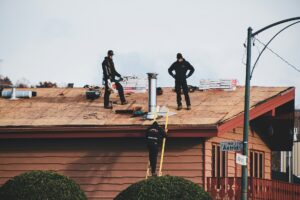A new roof isn’t just about shingles, underlayment, or the contractor you hire—it’s also about the peace of mind that comes from a solid roof warranty. Roofing warranties can vary widely in what they cover, how long they last, and which conditions apply. From typical manufacturer guarantees on materials to the contractor’s workmanship coverage, it’s important to understand the fine print. In this guide, we’ll help you see through the legal jargon, compare different types of warranties, and outline steps that keep you (and your roof) protected in the event of damage or defects.
The Importance of Roofing Warranties
A new roof can be a significant expense, often lasting between 20 and 50 years depending on the materials used. Warranties not only protect your investment but also offer the following benefits:
- Peace of Mind: Knowing you have formal coverage helps you sleep better during storm season or extreme weather.
- Potential for Reduced Repair Costs: If the warranty covers materials or labor, you may pay little to nothing for necessary fixes.
- Clarity of Responsibility: A clearly written warranty sets expectations for which issues fall under manufacturer or contractor coverage, preventing confusion if problems arise.
According to the National Roofing Contractors Association (NRCA), homeowners should review both product and workmanship warranties and ask questions before the project begins—especially about exclusions and maintenance requirements.
The Two Types of Roofing Warranties
Broadly speaking, homeowners commonly encounter two main warranty types that can overlap or exist independently:
Manufacturer (Material) Warranty
- Coverage Scope: Defects, premature aging, or production flaws specific to shingles or other roofing materials (tiles, metal panels, etc.). If there’s a problem with how the product was made, this warranty might pay for replacement materials.
- Timeframe: Basic warranties often range 20–30 years, while premium products—like architectural shingles or metal roofs—can advertise lifespans of 40–50 years. Some come with “lifetime” marketing terms, but read the actual documentation to see what “lifetime” truly entails.
- Limitations: Most material warranties don’t cover labor costs. If shingles fail, you may still pay for installation, tear-off, and disposal. Also, inadequate ventilation or improper installation can void coverage.
Workmanship (Contractor) Warranty
- Coverage Scope: Flaws or mistakes tied to the installation process—like improper flashing around chimneys or nails driven incorrectly.
- Timeframe: Varies greatly. Some contractors offer just one year of workmanship coverage, while others provide 5, 10, or more years.
- Validity: This coverage remains in effect only if certain maintenance guidelines are met. If you ignore recommended inspections, or if another contractor later alters the roof, your coverage might end.
- Transferability: Ask if the workmanship warranty can transfer to a new owner if you sell. This can be a selling point, especially in competitive housing markets.
Full-System Warranties
In some cases, homeowners can purchase or qualify for a full-system warranty that covers both materials and workmanship for specified components. These extended warranties, which come from roofing manufacturers via certified contractors, can offer:
- Comprehensive Protection: A single agreement that takes care of both defective shingles and issues with how the roof was installed.
- Specific Requirements: Usually, you must use approved underlayment, venting, flashing, and hire a contractor certified by that manufacturer. This ensures all roof components come from (or are endorsed by) a single brand.
- Additional Costs: Full-system warranties often cost extra. Some require an inspection fee or registration within a certain timeframe.
For example, if you opt for a certain brand’s asphalt shingles, you might also need to use the same brand’s ridge vents, ice-and-water barrier, and starter shingles—and then hire a contractor recognized by that brand. The bonus is that the entire system is designed to work together and covered under a single umbrella.
Key Warranty Terms to Understand
Warranty documents can be confusing. Here are relevant phrases or clauses you might encounter:
Prorated vs. Non-Prorated Periods
- Non-Prorated: The manufacturer covers the materials at 100% for a set initial period (e.g., the first 10 years). During this time, defective items might be replaced free of charge, though labor is extra unless stated.
- Prorated: Coverage diminishes with each passing year. If your shingles fail in year 12, you might only get partial credit for replacement based on a formula in the warranty.
Exclusions
- Acts of Nature: Hailstorms, hurricanes, or tornadoes may not be covered if your region’s weather exceeds what standard roofing is designed to handle (unless you specifically purchased hail- or wind-resistant shingles).
- Poor Ventilation: Improper attic airflow often leads to shingle deterioration, and manufacturers typically won’t cover such scenarios.
- Improper Maintenance: If you let debris accumulate or fail to fix minor issues promptly, your claim could be denied.
Transferability
- One-Time Transfer: Some warranties allow one transfer to a new homeowner if you sell the house during the warranty period. Others can’t be transferred or require a fee to do so.
- Reduced Coverage upon Transfer: Even if transferable, coverage might downgrade—perhaps from a 50-year to a 10-year term for the new owner.
Workmanship Limitations
- Coverage Duration: While a roofing product might advertise a 30-year lifespan, a workmanship warranty might be only 5 or 10 years.
- “Misapplication of Materials”: Contractor warranties often revolve around proper installation. If the contractor missed a flashing detail or didn’t nail the shingles per specs, they’re liable—provided you’re within the coverage window and you meet other conditions (like timely notification).
Factors That Affect Warranty Eligibility
A roofing warranty is only as solid as the compliance behind it. To stay fully protected, homeowners should:
- Hire Qualified Pros: Reputable roofing contractors ensure the roof is installed per all codes and manufacturer instructions, which is a prerequisite for most warranties.
- Follow Maintenance Recommendations: Check attic ventilation, clear gutters, and fix minor leaks quickly.
- Keep Records: Save your receipts, installation photos, permits, and any communication with contractors. This paper trail can be invaluable if you file a claim.
- Register the Warranty: Some products require online or mail-in registration within a certain period after installation. Missing this step might reduce or void coverage.
Filing a Claim: What to Expect
Should you need to file a claim, prompt action often leads to the best outcome. Steps generally include:
- Review Your Documents: Pinpoint if the issue is likely manufacturing (e.g., unexpected curling only a few years in) or installation (water intrusion near the chimney).
- Contact the Roofer or Manufacturer: Depending on your coverage, you may first call your contractor or call the product warranty hotline. Provide photos, your contract, and a detailed explanation of the problem.
- Inspection: The manufacturer or contractor might send an inspector to evaluate the roof. They’ll look for signs of improper maintenance, ventilation, or other disclaimers.
- Resolution: If approved, they may supply replacement materials, labor, or both. If denied, you can appeal (depending on the warranty) or seek an independent assessment from a local roofing association or inspector.
Be aware that natural aging or typical wear isn’t typically grounds for a warranty claim. Roof warranties aim to cover abnormal failures, not normal life-cycle degradation.
Real-World Example
Consider a homeowner, Maria, who replaced her old roof with 30-year asphalt shingles from a major brand. She hired a manufacturer-certified contractor and opted for a system warranty that covered both materials and workmanship for the first 10 years. Five years later, Maria discovered a small leak near a vent pipe. She followed these steps:
- Gathered Her Documentation: She had the warranty certificate and her roofer’s contact details.
- Called the Contractor: They arrived within a week, inspected the leak, and confirmed an installation oversight—a missing shingle nail seal around the vent.
- Cost to Maria: Nothing. Because she was still within the first 10 years, and good maintenance was documented (gutters were clear, no questionable modifications), the contractor repaired the leak under the workmanship coverage.
- Lesson Learned: Keeping thorough paperwork and using a certified installer had saved her potential out-of-pocket repairs.
This scenario underscores how a well-chosen and properly maintained warranty can spare homeowners from expensive fixes.
Common Warranty Misconceptions
“Lifetime Warranty = Zero Cost Repairs Forever”
- Reality: “Lifetime” often applies to the product’s expected useful lifespan, not literal indefinite coverage. Plus, coverage might be prorated over time and seldom includes labor indefinitely.
“One Warranty Covers Everything”
- Reality: The manufacturer’s warranty typically covers only the materials. Workmanship coverage stands separately—unless you secured a comprehensive system warranty.
“I Can Neglect My Roof and Still Be Covered”
- Reality: Warranties typically require routine upkeep. Ignoring leaks or failing to clear gutters can void your coverage for weather-related or moisture issues.
Tips for Maximizing Your Warranty Protection
- Select Quality Materials: Cheaper shingles with limited warranties allow some savings upfront—but might come with minimal coverage or higher risk of issues down the road if your region faces frequent storms.
- Hire Credentialed Contractors: Look for roofing pros with manufacturer certifications, proven local references, and thorough knowledge of building codes.
- Schedule Annual or Biannual Inspections: A quick, routine check helps catch small leaks or ventilation problems before they escalate. Keep documentation of these visits.
- Ask About Extended Coverage: If you want more robust protection, see if the manufacturer offers an option for next-tier coverage. This might cost extra but can include longer no-prorate periods or cover labor.
- Understand Wind/Hail Exclusions: If you live in a storm-prone area, consider shingles certified for high-wind or hail resistance. Warranties might specify up to a certain wind speed or hail diameter.
For more on recommended roofing best practices and typical coverage, resources like This Old House’s roofing archives and the Better Business Bureau for contractor checks can be helpful.
Crafting a Warranty Checklist
Unsure how to compare warranties from different manufacturers or contractors? Here’s a quick reference:
| Category | Questions to Ask or Check |
| Coverage Duration | How many years are fully covered (non-prorated)?What happens after that initial period? |
| Workmanship | How long does the contractor back their labor?Are any repairs fully covered, or only partial? |
| Transferability | Can it transfer to a new owner?Is there a fee or limit on transfers? |
| Exclusions | Storm damage?Incorrect installation or poor maintenance?Specific materials (like flashing) not included? |
| Required Maintenance | Do I need annual checks from a certified contractor?Is ventilation or gutter upkeep mandatory? |
| Claims Process | Who do I call first in case of trouble?Will they send someone for inspection? |
Bringing these questions to your contractor or carefully reviewing the manufacturer’s PDF or pamphlet helps you avoid frustrating surprises later.
Final Thoughts
A solid roofing warranty is as crucial as the shingles themselves. It means that if manufacturing flaws or installation errors surface, you won’t be left footing a potentially major bill. Still, warranties aren’t one-size-fits-all—each one differs in coverage duration, claim processes, and maintenance mandates. By understanding the nuances between manufacturer and workmanship warranties, clarifying coverage limitations, and working with a reputable roofing contractor, you can secure a roof that’s both durable and backed by reliable protection.
Ultimately, it’s worth investing time into reading the fine print and asking targeted questions. A bit of homework up front can translate into years of confidence, knowing that if you ever face a roofing mishap, you’ll have a clear path toward resolving it without blowing your budget. When quality materials, proper roofing installation, and consistent upkeep all align under a well-structured warranty, you’ll rest assured your roof is built and covered to last.




